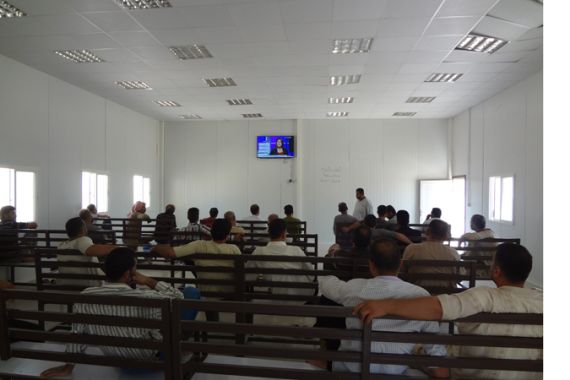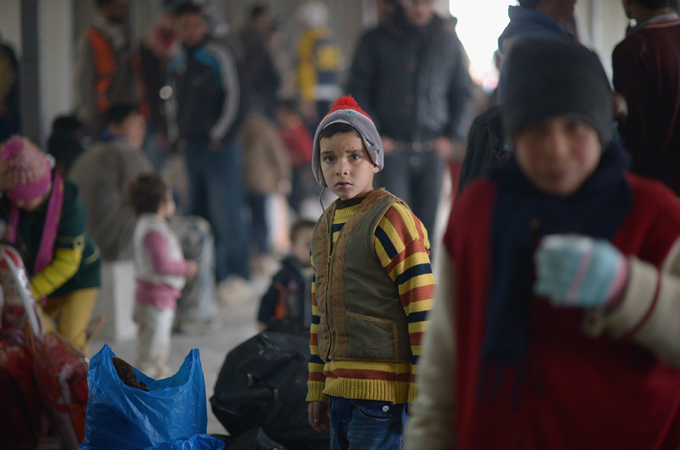A tale of two refugee cities
Many Syrians who fled to Jordan must endure a crowded UN camp, or the ordered boredom of the UAE’s ‘five-star’ compound.

Mrajeeb al-Fhood, Jordan – Not all refugee camps are created equal. In Jordan, two house Syrians and both the lifestyle of its residents and the way they are administered differ markedly.
The first, Zaatari, was built in two weeks in July 2012 near the Syrian border by the United Nations High Commissioner for Refugees, after Jordan’s government said the country could not house any more refugees in its cities. It is now “home” to more than 120,000 people, and riots are common at the camp and crime remains a problem.
The second, the Emirates Jordanian Camp (EJC), was opened in April by the United Arab Emirates, 20km from the city of Zarqa in the eastern desert.
It is financed entirely by the UAE through its Red Crescent Society and has ample electricity, running water, and roofed lodging for its roughly 3,400 residents. Many aid workers have dubbed it a “five-star” camp.
The contrasts could not be more stark.
Life is good here, but when the war ends, In'shallah, I will return home.
While Zaatari has met – and in many instances exceeded – all its basic humanitarian standards, Aoife McDonnell, a UNHCR relations officer, admits it is “not a comfortable camp”.
Zaatari had to be set up in a short period as an emergency response, after the Jordanian government said the country could no longer accommodate more Syrians in its cities.
“We had to be able to set it up quickly. We had to make sure life-saving assistance was and is delivered in the best and most efficient way,” McDonnell said.
Critics say, however, that Zaatari has become a shantytown of tents, and a hotbed of unrest. A July report titled “From slow boil to breaking point” by the UNHCR said some residents speak of a desire to “escape”.
Supermarkets and surveillance
But in the EJC, order prevails. Identical, prefabricated white caravans house one family per unit (the camp does not usually accept single men or parents with children above 18 years of age).
Comfort is extended to the EJC’s staff, almost all of whom are Emirati nationals. According to Mahmoud Sharafi, a Red Crescent employee of the camp, aid workers live in an enclosed area adjacent to the EJC. Should they need a break, villas in Amman are available.
Also inside the EJC is a school, a supermarket, a majlis for socialising, medical facilities, tailors, barbers, a children’s playground, and media centres.
But amid all the comfort and security, residents and critics complain about the EJC’s marked lack of freedom. In order to leave the camp, for instance, Syrian refugees would require a Jordanian sponsor – as is the case in Zaatari – but high metal fencing, surveillance cameras, and spotlights ensure this rule is more adhered to here.
Journalists are also closely monitored. Despite a press pass from the Ministry of Interior, an employee of the Red Crescent as well as a member of the Jordanian police escorted Al Jazeera on a tightly controlled tour.
 |
| The Zaatari refugee camp suffers from crime [Getty Images] |
EJC media representatives avoided repeated requests for comment.
Privately, many aid workers say these types of Gulf-funded camps are not always cost-effective, or particularly well-administered in the long run. The UAE spent $9.8m building the EJC, but it houses only a fraction of the people in Zaatari.
Nor are these types of Gulf-funded camps usually nimble enough to quickly take in large influxes of refugees. The EJC, for instance, has been slow to expand even though it intends to eventually have a capacity of 25,000.
Zaatari, by comparison, can readily host another 20,000 people. Once that capacity is reached, a new refugee camp in Azraq will be opened and it too will have an eventual capacity of more than 100,000, aid workers on site told Al Jazeera.
Longing for home
As for the Syrians in the EJC, its relative luxury makes one almost forget why its residents are here – that is, the brutal two-and-a-half-year conflict in which more than 100,000 people have died. According to some estimates, up to half of Syria’s population could be internally displaced or seeking refuge in neighbouring countries by the end of the year.
“Life is good here, but when the war ends, In’shallah, I will return home,” says Mohammad, an elderly man from Daraa. He spends most of his days indoors avoiding the desert’s punishing heat.
“We have no homes anymore,” says another named Reda. Like the majority of residents Al Jazeera spoke to, his was destroyed in the war.
While Reda has almost everything provided for free, he is left idle for hours each day. And while Zaatari has more than 3,000 shops and countless entrepreneurs, nothing comparable exists here.
And, as the Syrian conflict continues with no end in sight, the EJC’s residents may be forced to get accustomed to a more permanent stay in the camp and in Jordan, even as many long for their past lives in Syria.
“We’ve had enough,” said one outspoken resident. “We’ve suffered enough already. We want to return home.”
Adam Rasmi is the Features Editor for NOW Lebanon. Follow him on Twitter: @adamrasmi